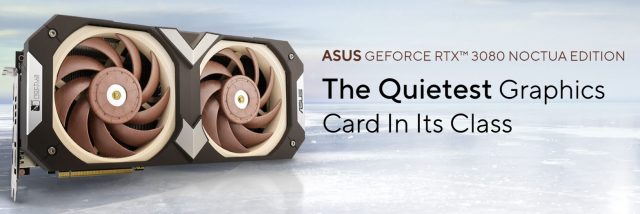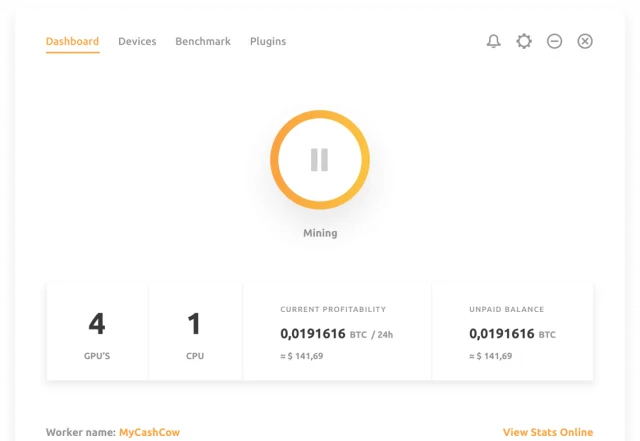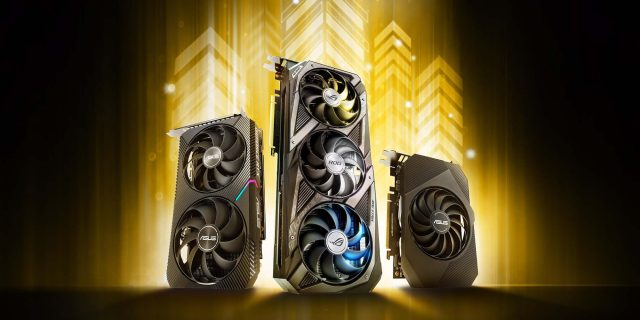A lot has happened to the largest GPU manufacturer brand run by leather jacket man Jensen Huang, be it good news or bad news. Here’s a quick update for all things NVIDIA.
Noctua knocks on ASUS’s door yet again

Still remember the ASUS GeForce RTX 3070 Noctua Edition that happened more than 6 months ago? Apparently, the reception of the second-tier RTX 30 series GPU with monstrous air-based cooling is so dang high that the two brands are convinced to push forward due to the amount of thermal headroom provided by the design. Therefore, the GeForce RTX 3080 version is born. Compared to competing models, it is said to achieve 3°C lower GPU core temperature and 14°C less reading for the VRAM all the while operating at way less noise than usual when using the default Auto-Fan setting.
The form factor, use of the NF-A12x25 pair, dual BIOS support, and custom heatsink are basically identical to the RTX 3070 but with more horsepower, thanks to the higher grade binned GPU silicon. Extra GPU power = extra heat due to the 340W TGP, you said? Well, you can apply the same logic to Noctua as referencing video and audio products by Sony to someone, it almost and hardly goes wrong by any chance.
The price of this card in Malaysia is at RM5,210 and paying for something that is both strong and chilled properly without relying on liquid cooling, it’ll definitely be as popular as the RTX 3070 version.
100% brain power for solving 1+1

To thwart off miners hogging all the GPUs that were supposedly made for you and me, NVIDIA has implemented hardware-based mining limiters called LHR onto the GeForce RTX 30 series offerings and released them into the market hoping it could somehow boot off crypto bro’s prying eyes and let gamers game at peace. Over the course of 2021 and until not long ago, we have seen malware disguised as “LHR unlockers”, Team Green screwing up and releasing non-public drivers that can bypass the limiter natively, users sticking HDMI dummy plugs to cheat the verification of display connections, and among all the other possible ways to get away with high hash rates.
1 year has passed and NiceHash has announced that they have fully bypassed LHR and updated their NiceHash QuickMiner software to let all users running LHR cards harness the “full power” to continue crunching numbers away. However, NiceHash did mention that the RTX 3050 and 12GB VRAM versions of the RTX 3080 are unsupported at the moment.
But as Ethereum which is one of the most popular cryptocurrencies mined preferably with NVIDIA cards inevitable shifting from “Proof of Work” to the “Proof of Stake” network, the LHR mission will still come to end sooner or later with analysts expecting little to no effect on the current GPU pricing.
Bright future for Linux gamers

We’ll need to take a trip back to February when cybercriminals group Lapsus$ claimed that they have hacked NVIDIA and stolen nearly 1TB of confidential data but they did not demand stuff like a stated number of cryptocurrencies to be paid as ransom rather they want the source code of LHR to be publicized. While the GPU giant didn’t cave in to those demands, today we have NiceHash somehow done the job for NVIDIA while Team Green pulled another gun out of their sleeve which is open-sourcing its GPU driver for Linux kernels.
Despite being the slowest compared to the likes of Intel and AMD that have been doing for like several years, this will finally mark an end to big brain Linux engineers chugging away coffees and energy drinks to try and reverse engineer drivers just to get them working on not only just Linux but also legacy hardware and dedicated distros.
But there’s a catch. NVIDIA is currently doing this under a dual MIT/GPL license which does not include driver parts that run in user space including but not limited to OpenGL, Vulkan, OpenCL, CUDA, and GPU System Processor (GSP) firmware for which all of these would be proprietary, confidential, and released with pre-built binaries. Additionally, only the GTX 1600 series, RTX 20, and 30 series are included in the support list. Anything older than that is a big NO.
In short, unless you want to contribute to this new yet familiar Linux GPU scene or simply be the lab rat yourself, you don’t really have a practical reason to jump the gun this early.
ASUS being sussy baka in the GPU market

Coming from one of the big players in the market, ASUS has announced that they are aggressively slashing MSRP across every graphics card SKU because the demands for them are simply aren’t as crazy compared to the crypto boom that happened 2 years ago. While scalpers still do what scalpers do, there are simply fewer reasons for them to be as active, resulting in GPU stock levels getting back to a healthy state but the prices are still a bit hard to swallow, not until April 1 when the “not so funny joke” happened to be true and ASUS-branded graphics card are seeing price cuts across every continent, including Malaysia.
While it is definitely one of the good news, to see ASUS be the earliest brand that pulls the trigger can signify that next-gen GPU products are closer than ever with NVIDIA’s Lovelace-based cards rumored to be released “early Q3”. But if you don’t care about the latest and greatest and just can get what you can with your limited budget, I’d say that the RTX 30 series still offers absolute value but only if they can actually meet the MSRP they were meant to be priced.










